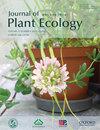半干旱草地无性系牧草叶片性状对铵硝比的响应:叶片顺序的影响
IF 3.9
2区 环境科学与生态学
Q2 ECOLOGY
引用次数: 0
摘要
叶子是光合作用的主要器官。叶片的表型可塑性在很大程度上决定了植物对富氮环境的适应性。然而,在环境和富氮条件下,代表整个植株叶片性状的最佳叶片数量(比例)是否相似尚不清楚。此外,大气氮沉降中铵态氮(NH4+ -N)与硝态氮(NO3—N)之比的变化是否会改变最佳叶数尚不清楚。2020年8月,通过对2014年以来中国北方温带草地施加3种NH4+ -N /NO3——N比率的方法,测定了羊草(Leymus chinensis)和冰草(Agropyron cristatum)两种优势克隆草的叶面积、厚度和叶绿素含量。结果表明:在环境条件下,除羊草(L. chinensis)需要5片叶片(占植株叶片的78.82%)外,2片完全展开叶片的平均叶面积、厚度和叶绿素含量与植株水平上所有叶片的平均叶面积相似;NH4+ -N /NO3—N的比值增加了所需取样叶片的数量,显著改变了叶片性状的平均值和沿叶序的最大值。此外,NH4+ -N /NO3——N的比值通过增加叶面积和减少叶厚度来改变叶片3个性状之间的权衡关系,而这取决于叶片的顺序。因此,我们的研究表明,为了更好地反映富氮条件下整个植株叶片性状的价值,需要测量所有充分展开的叶片或提供合适的放大参数。本文章由计算机程序翻译,如有差异,请以英文原文为准。
Leaf traits of clonal grasses responding to the ratios of ammonium to nitrate in a semi-arid grassland: leaf order matters
Leaf is the main organ of photosynthesis. Leaf phenotypic plasticity largely determines the adaptation of plants to enriched nitrogen (N) environments. However, it remains unclear whether the optimal number (proportion) of leaves representing the leaf traits of the whole plant is similar between ambient and N-enriched conditions. Moreover, whether alteration in ammonium (NH4+–N) to nitrate (NO3––N) ratios in atmospheric N deposition will alter the optimal leaf number is unexplored. By adding three NH4+–N/NO3––N ratios in a temperate grassland of northern China since 2014, three traits (leaf area, thickness, and chlorophyll content) of two dominant clonal grasses, Leymus chinensis and Agropyron cristatum, were measured in August 2020. Results showed that under ambient conditions, the mean leaf area, thickness, and chlorophyll content values of two fully expanded leaves were similar to these of all leaves at the plant level, except for the leaf area of L. chinensis, which needed five leaves (78.82% of leaves in the plant). The ratios of NH4+–N/NO3––N increased the number of required sampled leaves and significantly changed the mean value of leaf traits and the maximum value along leaf order. Moreover, the ratios of NH4+–N/NO3––N altered the trade-off among the three leaf traits, which is dependent on leaf order, by increasing leaf area and decreasing leaf thickness. Therefore, our study suggests that to better indicate the leaf traits’ value of the whole plant under N-enriched conditions, measuring all fully expanded leaves or providing a suitable scaling-up parameter is needed.
求助全文
通过发布文献求助,成功后即可免费获取论文全文。
去求助
来源期刊

Journal of Plant Ecology
生物-植物科学
CiteScore
4.60
自引率
18.50%
发文量
134
审稿时长
3 months
期刊介绍:
Journal of Plant Ecology (JPE) serves as an important medium for ecologists to present research findings and discuss challenging issues in the broad field of plants and their interactions with biotic and abiotic environment. The JPE will cover all aspects of plant ecology, including plant ecophysiology, population ecology, community ecology, ecosystem ecology and landscape ecology as well as conservation ecology, evolutionary ecology, and theoretical ecology.
 求助内容:
求助内容: 应助结果提醒方式:
应助结果提醒方式:


